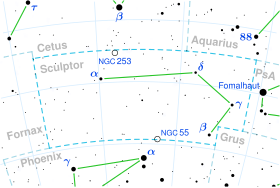
Summary
ι Sculptoris, Latinized as Iota Sculptoris and abbreviated iot Scl, is a solitary[11] star in the southern constellation of Sculptor. It is visible to the naked eye as a dim, orange-hued point of light with an apparent visual magnitude of 5.18.[2] The star is located approximately 336 light years from the Sun based on parallax,[1] and is drifting further away with a radial velocity of +21 km/s.[6]
| Observation data Epoch J2000 Equinox J2000 | |
|---|---|
| Constellation | Sculptor |
| Right ascension | 00h 21m 31.19799s[1] |
| Declination | −28° 58′ 53.2957″[1] |
| Apparent magnitude (V) | 5.18[2] |
| Characteristics | |
| Spectral type | K0III[3] |
| U−B color index | +0.84[4] |
| B−V color index | +1.00[5] |
| Astrometry | |
| Radial velocity (Rv) | +20.60[6] km/s |
| Proper motion (μ) | RA: +33.263[1] mas/yr Dec.: -72.065[1] mas/yr |
| Parallax (π) | 9.7081 ± 0.1287 mas[1] |
| Distance | 336 ± 4 ly (103 ± 1 pc) |
| Absolute magnitude (MV) | 0.16[2] |
| Details | |
| Mass | 2.94[7] M☉ |
| Radius | 12.28[7] R☉ |
| Luminosity | 97[7] L☉ |
| Surface gravity (log g) | 2.48[8] cgs |
| Temperature | 5,020[7] K |
| Metallicity [Fe/H] | +0.09[2] dex |
| Rotational velocity (v sin i) | 3.1[9] km/s |
| Other designations | |
| Database references | |
| SIMBAD | data |
This is an aging giant star with a stellar classification of K0III,[3] currently on the red giant branch.[7] It has 2.9 times the mass of the Sun and has expanded to 12 times the Sun's radius. The star is radiating 97 times the luminosity of the Sun from its enlarged photosphere at an effective temperature of 5,020 K.[7] These coordinates are a source for X-ray emission, which is most likely (99.4% chance) coming from the star.[12]
References edit
- ^ a b c d e f Brown, A. G. A.; et al. (Gaia collaboration) (August 2018). "Gaia Data Release 2: Summary of the contents and survey properties". Astronomy & Astrophysics. 616. A1. arXiv:1804.09365. Bibcode:2018A&A...616A...1G. doi:10.1051/0004-6361/201833051. Gaia DR2 record for this source at VizieR.
- ^ a b c d Anderson, E.; Francis, Ch. (2012). "XHIP: An extended hipparcos compilation". Astronomy Letters. 38 (5): 331. arXiv:1108.4971. Bibcode:2012AstL...38..331A. doi:10.1134/S1063773712050015. S2CID 119257644. Vizier catalog entry
- ^ a b Houk, N. (1982). "Michigan Catalogue of Two-dimensional Spectral Types for the HD stars. Volume_3. Declinations -40_ƒ0 to -26_ƒ0". Michigan Catalogue of Two-dimensional Spectral Types for the HD stars. Volume_3. Declinations -40_ƒ0 to -26_ƒ0. Bibcode:1982mcts.book.....H.
- ^ Mermilliod, J. C. (2006). "VizieR Online Data Catalog: Homogeneous Means in the UBV System (Mermilliod 1991)". VizieR On-line Data Catalog: II/168. Originally Published in: Institut d'Astronomie. 2168. Bibcode:2006yCat.2168....0M.Vizier catalog entry
- ^ Mallama, A. (2014). "Sloan Magnitudes for the Brightest Stars". The Journal of the American Association of Variable Star Observers. 42 (2): 443. Bibcode:2014JAVSO..42..443M.Vizier catalog entry
- ^ a b Wilson, R. E. (1953). "General Catalogue of Stellar Radial Velocities". Carnegie Institute Washington D.C. Publication. Carnegie Institution for Science. Bibcode:1953GCRV..C......0W. LCCN 54001336.
- ^ a b c d e f Jones, M. I.; Jenkins, J. S.; Rojo, P.; Melo, C. H. F. (2011). "Study of the impact of the post-MS evolution of the host star on the orbits of close-in planets". Astronomy & Astrophysics. 536: A71. arXiv:1110.6459. Bibcode:2011A&A...536A..71J. doi:10.1051/0004-6361/201117887. S2CID 55769003. Vizier catalog entry
- ^ Allende Prieto, C.; Lambert, D. L. (1999). "Fundamental parameters of nearby stars from the comparison with evolutionary calculations: Masses, radii and effective temperatures". Astronomy and Astrophysics. 352: 555–562. arXiv:astro-ph/9911002. Bibcode:1999A&A...352..555A. Vizier catalog entry
- ^ De Medeiros, J. R.; Alves, S.; Udry, S.; Andersen, J.; Nordström, B.; Mayor, M. (2014). "A catalog of rotational and radial velocities for evolved stars". Astronomy & Astrophysics. 561: A126. arXiv:1312.3474. Bibcode:2014A&A...561A.126D. doi:10.1051/0004-6361/201220762. S2CID 54046583. Vizier catalog entry
- ^ "iot Scl". SIMBAD. Centre de données astronomiques de Strasbourg. Retrieved 2019-09-09.
{{cite web}}: CS1 maint: postscript (link) - ^ Eggleton, P. P.; Tokovinin, A. A. (September 2008). "A catalogue of multiplicity among bright stellar systems". Monthly Notices of the Royal Astronomical Society. 389 (2): 869–879. arXiv:0806.2878. Bibcode:2008MNRAS.389..869E. doi:10.1111/j.1365-2966.2008.13596.x. S2CID 14878976.
- ^ Haakonsen, Christian Bernt; Rutledge, Robert E. (September 2009). "XID II: Statistical Cross-Association of ROSAT Bright Source Catalog X-ray Sources with 2MASS Point Source Catalog Near-Infrared Sources". The Astrophysical Journal Supplement. 184 (1): 138–151. arXiv:0910.3229. Bibcode:2009ApJS..184..138H. doi:10.1088/0067-0049/184/1/138. S2CID 119267456.



